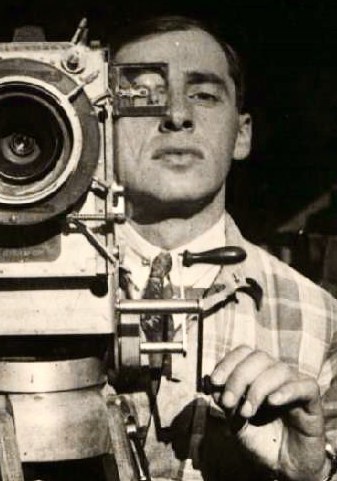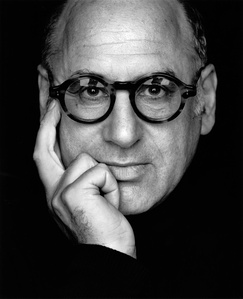持摄影机的人 Человек с Киноаппаратом(1929)

又名: Man with a Movie Camera / The Man with a Movie Camera / Chelovek s kino-apparatom
导演: 吉加·维尔托夫
编剧: 吉加·维尔托夫
主演: Mikhail Kaufman
类型: 纪录片
制片国家/地区: 苏联
上映日期: 1929-01-08(苏联)
片长: 68分钟 IMDb: tt0019760 豆瓣评分:9.1 下载地址:迅雷下载
简介:
- 本片是苏联纪录片导演,“电影眼”理论的创始人吉加•维尔托夫(Dziga Vertov)的代表作。电影主要拍摄于乌克兰的敖德萨市,摄像师是维尔托夫的哥哥米凯尔•卡夫曼(Mikhail Kaufman)。影片主要分观众入席、城市黎明、人民的工作与休息、体育运动和艺术实践几部分,通过刻画人民生活的方方面面来呈现苏维埃新社会中的一个理想城市。摄影师米凯尔•卡夫曼在拍摄的同时也出现在电影画面中,首创了“自我暴露”的电影形式。在这部具有里程碑性突破意义的纪录片中,维尔托夫首次使用了二次曝光、快进、慢动作、画面定格、跳跃剪辑、画面分割等前卫剪辑手法,并采用了仰角、特写、推拉镜头等新颖的拍摄手法,并制作了一段定格动画。
演员:
影评:
- 一个多小时的电影,看完后我居然一个人在家里面就鼓掌起来了。它让我再次发现真正的英雄们都是被忽略了的。无论是电影技术还是理论上的突破,这一部二十年代的苏联电影都远远胜于久负盛名的法国新浪潮。
虽然是一部社会主义的宣传片,内容上我就不予置评了,但从纯电影和摄影的角度来看,这部片子让我从头赞到尾,比如说:
1. 蒙太奇。蒙太奇。蒙太奇。它蜂拥而至打得你措手不及的剪辑们,把几年前爱森斯坦创造的蒙太奇技术发挥到了超前实验的高度。
2. 摄影师的自我暴露理念将这部电影引向了几乎算是哲学的深度。我们以为自己看到的一切是天经地义,习以为常的。但其实,这一切都是精心策划的筛选。
3. 无数的镜中镜,几乎可以算是维尔托夫对观众心理的一场大玩弄。不论画面是从静止的胶片转切到胶片上的这个电影,还是一次又一次,我们看到电影院里面的观众看电影。看的什么电影呢?就是我们现在看的这个电影。这让我想起那句著名的打油诗“从前有座山,山上有座庙,庙里有个老和尚跟小和尚讲故事。讲的什么呢?从前有座山……”自己小时候也曾多次想象,自己有一天能跳进电视机里面,把里面的虚构当现实。因此,他的这一套实验对我来说震撼之极。当我全屏看一段影片,然后又看到电影院里面的人在看这一段影片时,我不禁感到混乱与迷惘,我刚刚是在看自己么?
4. 强烈的对比,让这个完全没有语言与故事的摄像头讲述了超于画面的内涵。比如那一组结婚与离婚的组合,葬礼,生育,与婚礼的组合,美容的女人与劳动的女人之对比,都让人心里感慨万千。
5. 定格。我看到这些画面的时候简直就吐血了。法国新浪潮中,特吕弗的《祖与占》以几个定格镜头而闻名。但是没想到,早在三十多年前,人家苏联哥哥就已经创意出来了。而把静止的胶片当照片陈列再反复回转,同样混淆着大家的视线而具有高度的实验性与美感。
6. 双重曝光。把一个镜头嵌在另外一个镜头里面,这种技术在今天的电影里面是相当普遍的,数码技术来做也是相当简单的。但在二十年代, 这部电影就大篇幅的运用了这种重叠的效果,非常具有革命性。
7. 关于画面的分割,拍摄的角度等,这些都让我觉得之后的《奥林匹亚》和《公民凯恩》相比起来,也似乎不那么牛逼了。
8. 最搞的是居然还有动画。当然不是手工画的动画,而是一个镜头一个镜头连起来的实物动画,后来超现实动画大师史云梅耶的标签风格。说到超现实,这电影也很有几个镜头相当有味道,比如电影一开始,摄影师站在摄影机上面的这个镜头,以及摄影师站在啤酒杯里面的镜头,也都具有着深深的超现实风格。
你能想到,这是一部二十年代的电影么?它里面运用到的技术,当代都鲜有电影能相比。
这部电影在一开头是这样的几行大字:
"The film Man with a Movie Camera represents
AN EXPERIMENTATION IN THE CINEMATIC TRANSMISSION
Of visual phenomena
WITHOUT THE USE OF INTERTITLES
(a film without intertitles)
WITHOUT THE HELP OF A SCRIPT
(a film without script)
WITHOUT THE HELP OF A THEATRE
(a film without actors, without sets, etc.)
This new experimentation work by Kino-Eye is directed towards the creation of an authentically international absolute language of cinema – ABSOLUTE KINOGRAPHY – on the basis of its complete separation from the language of theatre and literature."
维尔托夫的这项声明看得我心情澎湃。真正的艺术啊…… - 这部无声的记录片是1929年的《持摄影机的人》。
即使在今天看来,这部电影依然可以算作比较具有实验性的作品,而它竟然出现在近80年前的苏联,距电影的诞生只有短短的34年,当时的电影还处于默片时代。
全片没有情节,只是不动声色的记录莫斯科的市景,街上形形色色的行人,店铺,工厂,电车,火车……
如果一直是这样,镜头只是像眼睛一样在观察,那么这部电影直接叫做《摄影机》也未为不可,但是既然片名叫做《持摄影机的人》,那么这个“人”的作用自然会在影片中体现出来。
于是,每当我们随着镜头看着莫斯科城中的各种景象,逐渐进入,逐渐放松,简直认为没有摄影机,也没有镜头后面的那个人的存在的时候,电影里就会出现摄影师的镜头,一会儿是他扛着摄影机寻找合适的角度,一会儿是他蹲在矿工后面拍摄矿工的劳动,让我们总是恍然大悟的想起原来我们看到的并非天生就有的景象,而是摄影机后面的这个人想让我们看到的东西,当我们看着教堂宏伟的尖顶的时候,如果摄影师将摄影机转个方向,我们将看到贫苦居民居住的小草棚;而如果摄影师不想让我们看到草棚的话,我们就只会为这教堂的壮观而赞叹——一切都取决于持镜头的这个人,此时此刻,我们都是他的臣民,我们都要遵从于他的意愿。
最有意思的是这样一组镜头:街上奔跑着一辆敞棚汽车,车里是几个打扮入时的阔太太,这样的镜头并没有什么特别,可这时,镜头切换,我们看到摄影师正坐在与敞棚汽车并行的另一辆敞棚汽车上,拍摄着阔太太们的一举一动。这就让人不由得想到,那么我们现在”所在”的镜头,岂不是另一辆与两辆车共行的汽车上的另一名摄影师的眼睛吗?
整部电影,似乎导演都在跟我们玩着同样的游戏——先让你放松警惕,进入他为你设置的环境与心情,然后忽然用一组镜头对你当头棒喝,告诉你:“这一切都不过是我为你安排的,你自己不可能自由选择,我让你哭你就要哭,我让你笑你就要笑,我让你看到的你就要看,我不让你看到的你休想看到……”
影片的蒙太奇镜头运用的很好,例如里面有一组镜头,分别是婚礼,葬礼,婴儿的出生,老人的死亡等等,我一面不无感伤的想到了人生无常世界广袤之类的词语,一面在心里知道又中了导演的套,我们已经太熟悉电影语言了,固定的场景我们就会产生与之相符的固定的情感,而我们毫无知觉。
还有一组镜头,一个女孩在射击,镜头快速的在她的枪口和靶之间切换,速度越来越快,这就说明子弹即将射出,可是切换了好多次子弹也没有射出,让人心里憋闷极了,呼吸都困难,还好最后子弹还是射出去了,如释重负的同时,心里又一次的感觉到了导演的诡计。:)
拿到了摄影机,就是掌握了话语权,就能任意的摆布观众,当我们沉浸在镜头为我们讲述的故事,铺设的场景的时候,我们有没有想到过镜头后面,那个“持摄影机的人”呢?
最近有本讲电影的书名叫《我的摄影机不撒谎》,而《持摄影机的人》要告诉我们的似乎是:摄影机永远不可能不撒谎。 - 在1929年的《持摄像机的人》的开头,导演吉加•维尔托夫邀请假想中的观众坐入电影院。这部以记录片著称的电影竟然以魔幻主义的手法开场:电影院中的椅子神奇地打开,仿佛具有自我意识那般邀请我们入座。电影院,对于苏联人维尔托夫来说,正是这个新世纪和新社会中的理想公共空间;如果一场社会主义实验将席卷这片红色土地的话,那么,这场革命必须从电影院这个黑暗的洞穴开始。
观众入座,电影即将放映,而被放映的正是《持摄像机的人》的主体部分:这是一次史无前例的视觉旅行,我们将随着镜头穿越一个城市、一个日夜,捕捉城市生产和再生产的每个悸动,并把它们编织成一支辉煌的都市交响曲。而我们也同时意识到,正是摄像机的发明才使这种视觉旅行成为了可能。
《持摄像机的人》标志着这样一个伟大的时刻:我们所栖息的都市突然具有了生命,而这种自在自为的生命通过一系列极为先锋的电影影像技巧呈现在我们眼前:升格摄影、降格摄影、双重暴光、快速蒙太奇等等。和大洋彼岸的好莱坞同仁不同,吉加•维尔托夫并不把这些刚刚发明的特技看作是迷惑眼球的伎俩;对于这位电影革命者来说,所有这些特技都是表征城市的必要手段。正如他在那热情洋溢的视觉革命檄文中所说的那样,所有这些都预示着“电影眼”(kino-eye)的诞生。不过,和寻常的理解不同,“电影眼”并非人体肉眼的单向衍生;它是肉体与机械的弥合,肉眼与工业视觉的杂生。只有在“电影眼”乃至在电影这一新兴媒介中,维尔托夫才找到了机械与劳动力之间的辩证平衡。
数十年之后,先锋导演大卫•柯南伯格(David Cronenberg)在他的《录像带谋杀案》等片中重复/倒置了这一辩证关系。那些从人类肉体中增生出来的机械或者机械的情欲化成为了后现代电影史中最令人毛骨悚然的意象,而与此相关的则是柯南伯格所着迷的后工业时代地下都城。这些欲望横流、阴郁冰冷的都市显然和维尔托夫在《持摄像机的人》中所建构的那个理想都城不同:那是莫斯科、敖德萨和基普的结合体,通过繁复的蒙太奇手法变幻成一个社会主义工业之城。
但是,和柯南伯格如出一辙的是维尔托夫把身体的生产—城市的生产—视觉影像的生产置于了同一个平面。在这一天的都市生产生活中,不同生产领域的工具与结构都通过蒙太奇手法被诗意地连接在了一起:比如说,火车轮、纺织轮和胶片滚轮,运输、生活资料生产与影像生产都在“电影眼”中呈现出相似的运作方式,并强调了普遍性生产方式的可能性。
如果说,对柯南伯格电影的标准马克思主义解读是,资产阶级个人在媒介时代中遭遇了最终的疏离,并通过放弃自己的主体性而得到了唯一救赎的可能性的话,那么,《持摄像机的人》刚好是马克思主义的反题:大工业生产并不必然产生疏离和物化,不同生产领域、不同工种之间都可以提炼出新的抽象形式。《持摄像机的人》以视觉的形式与《德意志意识形态》进行了对话。在后者中,纺织工业成为了整个物质生产历史的缩影,而在前者中,纺织工业中的滚轮和轴轮则成为了影像动力学的起点,从工业作坊到现代电影大工业,从衣物生产到视觉景观的生产,每一个生产门类都被历史化地连接在一起,现代都市以其意象上的相似性被巧妙地构想在了一起。
于是,马克思的劳动价值理论被发展成为蒙太奇理论。通过把社会各个部门的工业活动理性化、流程化和标准化(奇怪的是,和之后的文化批判者所设想的不同,这种重复的机械运动所暗含的并非剥削与日常生活的贫瘠,而是一种莫名的诗意),蒙太奇超越了电影技术本身的含义,而成为了现代生活的一种状态:它既是碎片,又把碎片有组织地连接在一起;这既是现代生活的本质,又是现代社会与电影叙事体系生产意义的方式。
当一种理想、理性的现代都市生活在《持摄像机的人》中被实现时,我们不能忘记的便是,只有在“电影眼”的关照下,这一切才能成为可能;我们也不能忽视那个仿佛多此一举的开场:对于维尔托夫的“洞穴人”来说,电影从来不是娱乐的幻影,而是教育和启迪的社会主义公民的方式。当维尔托夫说“电影眼”是“一种影像记录形式,它不仅解构那些肉眼所能看见的世界,也解构那个无法看见的世界”时,我们总是能从与他同时代的本雅明那里找到回应:“我们的酒店与都市街道,我们的办公室与起居室,我们的火车站与工厂,所有这些都仿佛把我们毫无希望地囚禁了。然后,电影来了,它以十分之一秒的速度、以炸弹那般的威力把这个监狱炸得粉碎,于是,现在,我们终于可以在废墟之中自由自在地畅游。特写让空间扩大;慢动作让时间延长。随着摄像机的升高和降低,电影介入了我们的生活……它带我们进入了一个无意识的视觉世界,就像心理分析带领我们进入一个无意识的欲望世界。”于是,在维尔托夫所想象的城邦中,电影以救赎者的身份降临了,社会的表层被光束穿透,被掩盖的社会关系在晦明之中更为清澈;当来自各个阶层、各个领域的公民在电影院中聚集,启迪的时刻就此来临。 - Man with a Movie Camera is a highly experimental film by Russian director Dziga Vertov, which generally shows urban life forms in modern Soviet Union in a cameraman’ s perceptions.
Without any actors or sets, Vertov turned his camera to life reality itself. He captured objects in emotional qualities, inter-cut shots of people without awareness, and flashed quickly over structures. Camera quickly sliding over the surface of Soviet cities, I felt it could freeze any moment into film, expose any details onto the screen.
While watching this film, I felt myself like Vertov’s pair of eyes sensitive to any outside changes without any words. Along with his camera rolling, my eyes kept watching out. Underneath, there indeed was a conversation between Vertov and me. We kept arguing beyond the experiences of this film: the meaning each shot convey, the state of human being, the essence of life etc. And those motion pictures reflecting on Vertoc’s life philosophy gave me a general impression of what an industrial city is like and how its citizens lived there during 1920s.
Furthermore, instead of fully use of words, Vertov communicated his life philosophy with audiences by pure cinematic language. In my opinion, the most interesting thing is his visual ideas of time and space illustration. For instant, ordinary people could barely see if there is any combination between a scene of sleeping woman, a scene of cameraman, and a scene of running train. But Vertov successfully combined three scenes together with some sense of poetry. Such as, in the morning, the train was setting up from the station, but the sleeping woman felt too tired to get up for work. At the same time, the cameraman started to set up his camera. Then, the train kept running on its track, the woman still struggled to wake up. And the cameraman set his camera on the track and waited train’s coming. While the train looked like going crack up cameraman’s body, the woman was suddenly awake from nightmare. Seemingly, she saw the cameraman being cracked by train in her dream.
This is really a good example, which we could much learn about how Vertov used the changing space to illustrate time, and how he brought up the idea of making this surreal montage. I believe, learning how to illustrate time and space well is a most significant thing of making a film, specially on those films of universal themes.
On a more technical note, I felt Vertov much like to shoot objects from unusual angles and made them metaphors for other life forms in this movie. For example, a street in the morning, running machines, and quick walking people without expression, such images quickly sliding over the surface of modern Soviet life, were frequently seen in this film. After hiding himself behind the camera, Vertov traveled over time and space, located anywhere to capture what he believed is reality: the film playing on the screen is our real life. Actors playing inside the film are ourselves.


